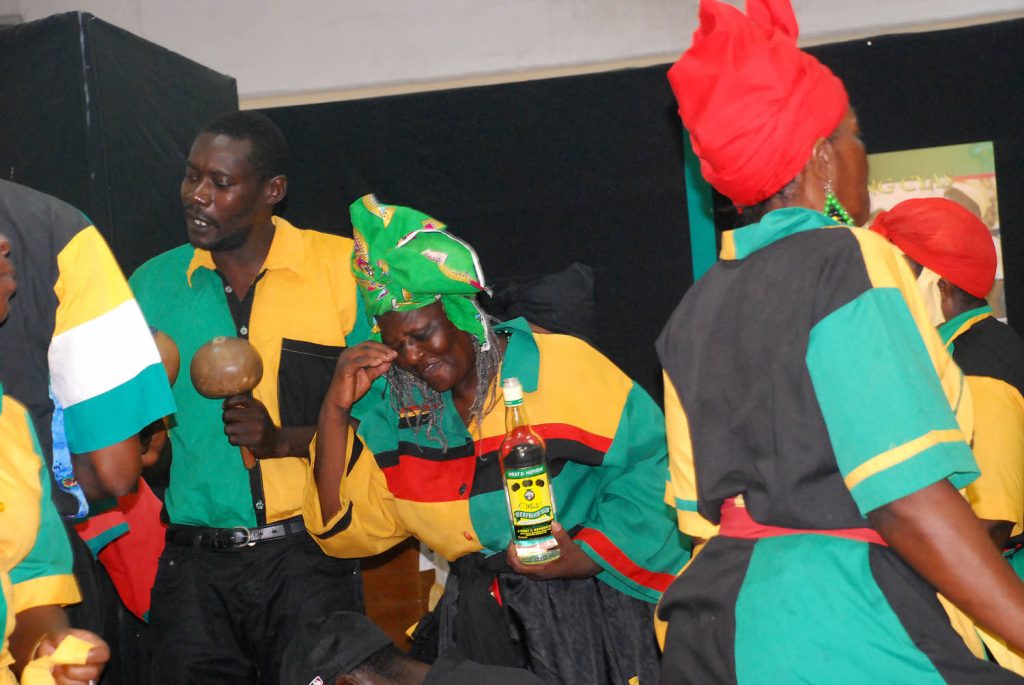St Thomas, commonly referred to as the “forgotten parish”, is located in the eastern part of Jamaica, and boasts a reputation as the established home of Kumina — also known as Kalunga or Kadunga. Travelling from Kingston into the parish is a battle between humans, vehicular traffic, stray animals, heat, and dust from a highway project currently under heavy construction, expected to transform the parish.
Still, there are numerous unexpected bonuses to reward any traveller seeking to experience Kumina — an expressive artform celebrating life, death, and spirituality through dance, music, and the Kikongo language — for the first time.
From the rugged beauty, pristine beaches, breathtaking sunset vistas and the world-famous Bath Fountain — lauded for its therapeutically healing treatments — this is St Thomas. St Thomas is also defined by Kumina — rooted in celebrating the ancestors (the original Bongo Nation), and embracing an authentic cultural legacy.
Rituals and ceremonies are performed for births, engagements and weddings, deaths, wakes, and entombment, while Kikongo is still spoken in Kumina communities — but is rapidly disappearing, except when chanted during specific Kumina ceremonies. There are also communities of Kumina practitioners in St Mary, St Catherine, Portland, and Kingston.
“[There] is a well-known traditional dance music in the Kongo region known as Kumunu,” explains Kenneth Bilby, prominent anthropologist and ethnomusicologist, speaking of the ancient central African Kingdom of Kongo (which once spanned parts of present-day Angola, the Democratic Republic of the Congo, Gabon, and the Republic of the Congo. “[The] drumming style itself is known as Kumunu [which] very closely parallels Jamaican Kumina drumming.”
“Bongo” as a term invokes the original Kikongo language, and among Kumina adherents refers to people of African descent. Bongo in the local dialect is often cast in a derogatory light due to the legacies of colonialism — not unlike perceptions some still hold about communities, descended from enslaved Africans, that practise Ifa, Vodou, Candomblé, Santería, and others.
However, members of the Kumina community have reclaimed this word as a legitimate source of power, their African pride, and identity.
“Bongo means real grassroots man, even though Bongo Nation is scattered,” states Lenroy Alexander, a longstanding member and elder within the Kumina community. It is the ritual drums — kbandu/bandu and playing kyas — that reinforce their link to the Bongo. Both drums speak, resist, and refuse to be silenced.
The drums are also a constant reminder of communal healing. Made from traditional tree trunks wrapped with strong vines sourced from tree barks, and headed by she-goat skin, the drums are made from the wood of cedar, trumpet, or breadfruit trees.
In the past, the drums were also constructed in disguise. The playing kyas, for example, were originally made from cask barrels that stored the rum from the sugar estates. To defy and keep the drums hidden from the (dangerously) prying eyes of the plantation overseers and masters, the playing kyas’ outward appearance would later be crafted similarly to the now famous Jamaican rum cask barrels.
Playing of these drums during ritualised performances is at the heart of Kumina. Captivating, pulsating rhythms emanating from the drums are attuned to the frenzied movements of dancers communing with the ancestral spirits.
Of course, the accompanying musical instruments — the shakka (made from seed or stone-filled gourds), katta or rhythm sticks (made from thin joints of the bamboo), and grater (the kind you might have in your kitchen and use to grate cheese!) are just as important.
The playing kyas and kbandu are like conversations between a man and a woman. Philip Supersad, sculptor and musician, likened the steady four-beat pattern of the kbandu (“dudum-dudum-dudum-dum”) to a very patient man saying “Yes, dear! Yes dear!” to soothe his wife; while the playing kyas respond with a very rapid, urgent, high-pitched, staccato rhythm (“peng-peng-peng”) that’s almost like a wife telling her husband to hurry home.
Kumina is not an adopted practice, but a way of life embedded in the psyche of the community
During Kumina, the drum rhythms affect your entire body, and are meant to transport participants to a higher plane. It’s an ongoing conversation between dancers and drummers, dancers and ancestors. The drummers also play a role in the dancers’ safety. This is where both kbandu and playing kyas take centre stage, as the ancestors are not only revered but feared.
Myaal is described as a portal or channel for connecting with ancestor spirits, and is commonly referred to as “catching the Myaal spirit”. As a manifestation of ancestral presence, this is perhaps one of the most intriguing aspects of Kumina. A personal encounter is not easily put into words or described from an academic point of view. In the words of spiritualist Simon Davis:
Myaal is a state of being, under the direction of the spirits. When the spirits come to you, these are related to the Africans from the olden days, old Africans the ancestors. You are a vessel through which the spirit speaks, and you also respond to the spirit. The ancestors show up in different forms.
There has been a deviation in the music of Kumina in recent years, but not by “true practitioners” — individuals for whom Kumina is not an adopted practice, but a way of life embedded in the psyche of the community.
The popular sound systems, generally reserved for dancehall spaces, are seen strung up at “Dead Yards” (or Nine-Nights, a funerary tradition also practised across the region). Kumina musicians must contend with the blaring sounds of speaker boxes and pop music.
Between 2003 and 2016, numerous reggae music producers also started a musical trend experimenting with Kumina music. The “Kumina Riddim” (a “riddim” being a produced instrumental track) emerged from this, with multiple reggae artistes adding their own unique vocals to the Kumina Riddim.
When this slew of riddims hit the airwaves and blared over speaker boxes, much to the delight of dancehall masses, the public was treated to songs titled “Kumina Rock”, “Dance Kumina”, “Wheel & Turn”, “Party up in Here” among other colourful and animated names.
For outsiders, the opportunity to witness Kumina in action might at first seem a bit intimidating, but it offers a glimpse of something far deeper. To understand Kumina is to observe and absorb community in action. “Like how yu cross de bridge fi come inna St Thomas, yasuh is weh wi mek cultural bridge,” a Kumina supporter stated with pride in Patois.
Gaining access into Kumina communities is not easy, since most are not within proximity of each other, and having someone with ties to the community is necessary.
Kumina remains at the heart of Afro-Jamaican traditions and culture, and continues to play a significant role in the remembrance of spiritual and physical liberation practised in this African-Atlantic environment. It is an invaluable part of Jamaica’s intangible cultural heritage, and one that the African Caribbean Institute of Jamaica/Jamaica Memory Bank is actively working to document and preserve.

